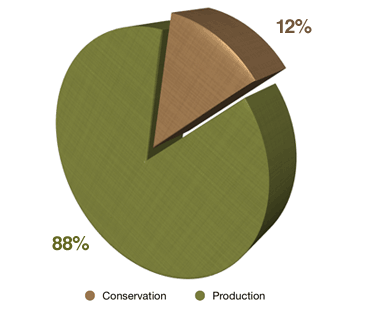EXECUTIVE SUMMARY – Page 3
EWG’s findings are an urgent reminder that the Corn Belt’s carpet of immensely fertile soil, a resource that accumulated over millions of years before European settlers introduced organized agriculture, is not inexhaustible. From the Dust Bowl of the 1930s to the barren moonscapes of today’s Haiti and Madagascar, history is littered with evidence that what nature has provided, unwise practices and policies can rapidly squander.
Today, the soil erosion problem in Iowa and nearby states is nowhere near the scale of those historic calamities, but the data show that the situation is getting worse. Chronically underfunded voluntary conservation programs are failing to blunt the damage caused by federal policies that push farmers to plant crops fencerow to fencerow. Between 1997 and 2009, the government paid Iowa farmers $2.76 billion to put conservation practices in place. It paid out six times as much — $16.8 billion — in income, production and insurance subsidies that encouraged maximum-intensity planting, not conservation. Across the Corn Belt, the gap was even greater — $7.0 billion for conservation and $51.2 billion for income, production and insurance subsidies.

The $18.9 billion spent to subsidize expansion of the corn ethanol industry, along with misguided federal mandates to produce increasing amounts of ethanol, further increase the pressure to intensify production.
To turn this situation around, the US Department of Agriculture (USDA) must step up enforcement of the groundbreaking 1985 farm bill provision — called conservation compliance — that required producers to take action to conserve soil in order to stay eligible for billions in farm subsidies. USDA must increase its annual inspections to determine whether producers are maintaining the required soil conservation practices and also make full use of its authority to impose graduated penalties on farmers who fail to keep the required practices in place.
In addition, EWG believes that Congress must:
- Reopen and revise all the legacy conservation compliance soil conservation plans approved and applied before July 3, 1996, requiring that they reduce erosion to a truly “sustainable” level and prevent ephemeral gully erosion on highly erodible cropland.
- Require treatment and/or prevention of ephemeral gully erosion on all agricultural land — not just highly erodible land — owned by producers or landlords receiving income, production, insurance or conservation subsidies.
- Require vegetative buffer zones at least 35 feet wide between row crops and all lakes, rivers, and smaller streams.
- Require all producers participating in existing or new crop and revenue insurance programs to meet conservation compliance standards.
- Ensure that farmers who convert native prairie or rangeland to row crops are not eligible to receive income, production, insurance or conservation subsidies on those acres.
- Adequately fund the USDA technical staff — out of funds provided for programs covered by compliance provisions — needed to plan and implement the required conservation practices and to conduct annual inspections to certify that those practices are in place.

 Twitter Updates
Twitter Updates


